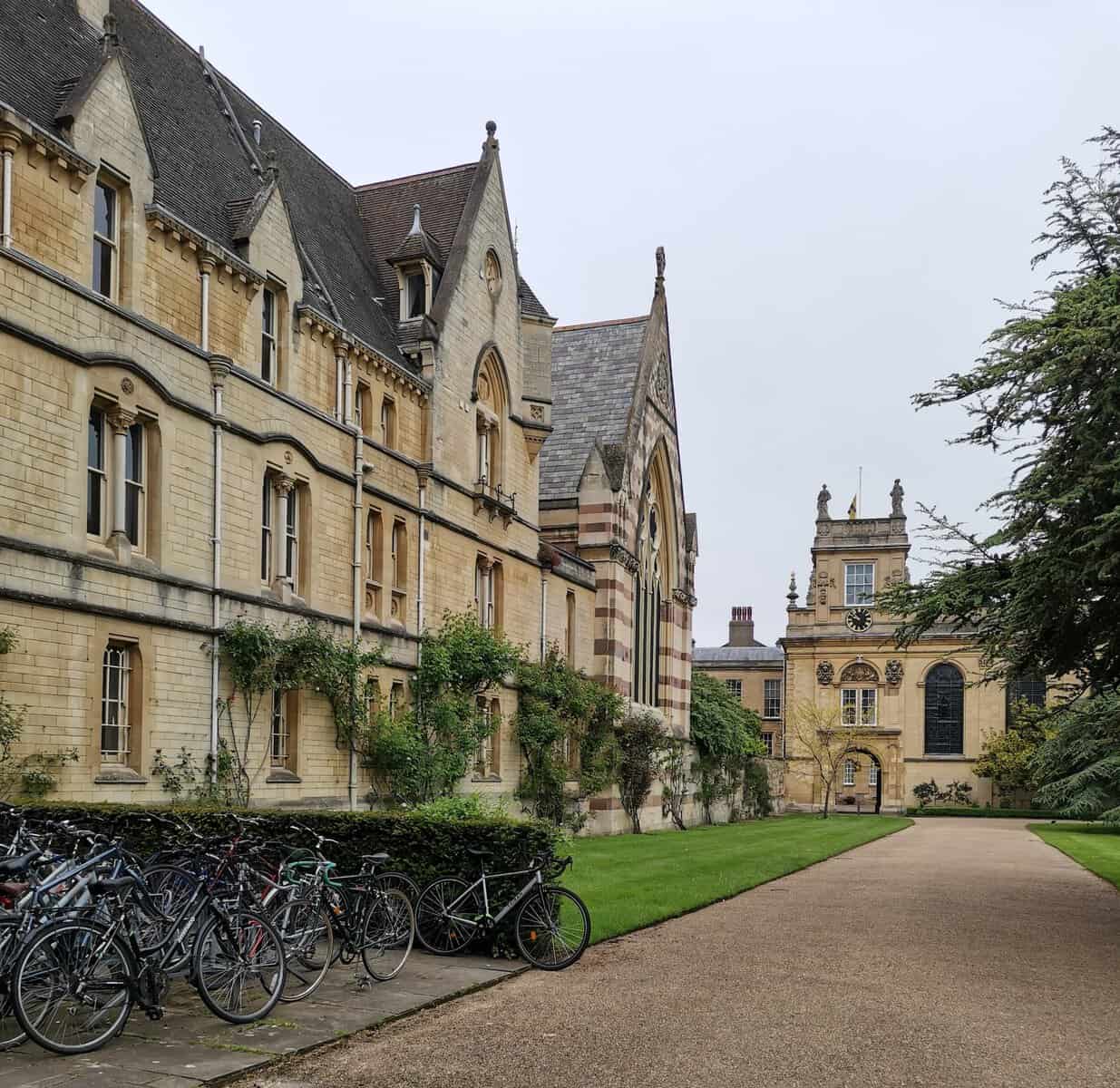Eyes on Downing Street: What is it Like to Study at Oxford University?

- Originally published
- Last updated on February 17th, 2024 at 08:40 pm
Table of Contents
They say the University of Oxford excels at politics, while Cambridge eyes the sciences. Is it true? We asked students: What is Oxford University like?
We wanted to know where international students had the biggest struggles, how university support stacked up against academic ratings, and even where the best places to hang out off campus were. While Oxford is the oldest university in the English-speaking world, it’s not the only one. Get the lay of the land in this guide, including the city of Oxford, the campus, academics, and basics of how to apply to get a feel for whether going to Oxford is right for you or not. After all, there’s always Cambridge.
And be sure to get the basics of how international students can research and apply to go to college in England.
University of Oxford Basics
Degrees: BA, MBiochem, MBiol, MChem, MCompSci, MCompSciPhil, MEarthSci, MEng, BFA, BA (Equivalent to LLB in law), MMAth, MMathCompSci, BM BCh, MPhys, MSci
Majors: Top ten programs in arts and humanities (first in the world), clinical medicine, endocrinology, environment & ecology, microbiology, psychology, immunology, and public/occupational health.
Location: Oxford, Oxfordshire, UK (about an hour northwest of London)
Cost for international students: £33,050 to £48,620 (continuing clinical medicine tuition is £57,690 for internationals)
On-campus housing cost: The college system means housing is variable and students don’t always get to apply to only the housing they prefer based on cost. Average costs range from £4,284 at St. John’s (before meals) to £7,368 at Harris Manchester, which does wrap meal charges into their housing. No college’s housing averages above £6,000 before meals.
FAFSA Funds: Yes
Abroad from abroad: Yes. Many 4-year programs include a year abroad, and opportunities range from the European Erasmus program to summer options and the UK’s work-abroad Turing scheme.
Student body: 26,000 (12,683 undergraduates, of whom 23%, or 2,917 are international). International enrollment at the graduate level is 65%.
Five adjectives: Aristocratic, political, traditional, personal, social
Living in Oxford City
It’s quite common to choose between Oxford and Cambridge based on their towns, which can look more dissimilar than academic programs if you’re in a traditional area like “math.” So let’s start by exploring the 10th-century city that British poet Matthew Arnold once called “the city of dreaming spires.”
Oxford is a happening metropolis compared to Cambridge. It’s a city of 152,000 residents, roughly the college town equivalent of Gainesville, Florida. Historically, it’s the home of academia in England, the place where displaced scholars settled in the 12th century when the king forbade Brits from attending the University of Paris. They responded by banding together and establishing their own seat of learning. Today, Oxford is a historical gem with castle vibes firmly set in the middle ages of its founding. It’s also well known for serving as the set for many a Harry Potter film.
The size is the best part of the city of Oxford. You see people you know quite often, and you can get around very easily. There’s also a lot to do, especially for students. There’s a fantastic live music magazine so you can check out new music. There are farmers markets. You can visit nearby towns like Woodstock.
Oxford is a convenient day trip from London. Take the train or the double-decker bus for about £20 each way, depending on whether you must travel at peak hours. Slice the price to around £13 with the Oxford Tube app and grab a double decker bus, complete with WiFi. It all means that students are well-connected to the capital’s academic resources, museums, and even nights out (though beware, the last train back to Oxford leaves around 12:30 am. After that, you’ll have to wait til 5:00 am).
Get your bearings by climbing the 12th-century Carfax Tower for a view over the colleges, two rivers, and town. The center of Oxford is fairly compact, and while a few colleges are far-flung, those in the center of the city are located conveniently to all the nightlife, restaurants, and clubs that Oxford has to offer.
Stop in the Bodleian Library’s Treasures Room and get acquainted with some of Britain’s history-makers, from King John and his Magna Carta to Shakespeare and his first-edition folio.
Head to Cowley Road for everyday necessities, like international groceries and vintage finds. The international presence on Cowley Street is decidedly British: you’ll find Turkish kebab cafés among Syrian, Indian, and Polish eateries.
What is Oxford University Like for Safety?
Further down Cowley Road, you’ll also start to see the famous tension between privileged “gowns” from Oxford and blue-collar “town” residents coping with the real problems of crime and safety in the otherwise picturesque town.
Overall, Oxford is #46 among English, Welsh, and Northern Irish cities and towns for crime. The most common crimes are violence and sexual offences. However, students on the ground don’t say they feel unsafe at Oxford. In fact, they universally say Oxford is very safe, both day and night. This bedroom commuter town, mostly populated by students and tourists, has its share of theft, and as one student put it, “there is always some opportunistic crime and some bike theft in a place like this.”
I have had only positive experiences in Oxford, even late at night. Everything is close to student accommodation, so that helps. And there are other students out all the time, so you won’t walk home in streets that are desolate.
Student Life Hotspots in Oxford City
Head to Il Botanico for a coffee and study session. Its vibrant greenery is sure to boost your mood, and you can easily find a seat and keep your laptop charged. Hit up Westgate and the Covered Market for shopping.
Need to let off some steam? Oxford is big enough that there are enough bars and clubs that locals can curate top ten lists of their favs. There’s likely a perfect pub for you and your friends, even though you’ll notice people head home (or back to the library?) a little earlier in the evening than if you studied in London.
Some notable spots to check out: The Mad Hatter pays homage to local boy Lewis Carroll. Its pink leather boots and karaoke nights are an apt celebration after putting yet another essay to bed. The terrace bar at Bridge, with its 3 stories of dance floors, is another prime location where you can forget that 300 pages of readings on your schedule. Thursday’s classic dance parties can cheer you up after a particularly bruising tutorial.
My favourite place to hang out in Oxford is Jericho Coffee Traders. It’s so cozy, and you can sit in the window, looking at historical views, while writing an entire paper and eating cake.
There are even a handful of LGBTQIA venues, including a pub where you can jump into a team for trivia night. While businesses, especially pubs, come and go in Oxford, the city is large enough to cater to many different people. You’ll even find Oxford Brooks students out on Cowley Street, grabbing a curry. It adds vibrancy to a university where the social life is notoriously confined to formal dinners, balls, secret societies, and on-campus venues.
Even if you never rent a punting boat and attempt to navigate the River Cherwell, you’ll find enough to do to keep you amused for your 3 or 4 years at Oxford. Students who aren’t happy studying away every weekend in their colleges gravitate toward the city, which has a bustling culture of its own.
What’s it Like to Live in Oxford Colleges and on Campus?
Oxford’s historical campus is hard to beat. With ivy-clad castle walls, its stone buildings have stood the test of time. Listen for church bells and enter fan-vaulted halls where your footsteps echo. You might catch the sounds of a choir rehearsing as gowned fellows hurry through stone gates. Head to the Vaults and Garden café for tea, lunch, and ambience in St. Mary’s Church, dating from the 1300s.
But wait! Want a modern college with modern architecture? You can do that, too. Physics students will spend lots of their time at Oxford in the 1960s Denys Wilkinson building, gazing out at the brutalist Van Der Graaf generator tower plopped atop the glass tower block. Those living in St. Catherine’s College can contemplate its 1960s Danish design.
The idea of a cohesive vibe or even a single “campus” is strange within the college system, where students come to know and love the extended families in which they cocoon themselves for 3 or 4 years, rarely experiencing the worlds of other students.
But underlying it all is a unifying “Oxford.” So what’s that even mean? Well, if you want to live the stereotype, you can spend your summers smacking around a croquet ball, punting on the river, and gearing up for the fall’s formal meals. You can check out the truly unparalleled library system, the quiet reading rooms, and the ancient town. Oxford is known for its “old” traditions and stereotypes, though not all students must lose themselves in history to study here.
Oxford has resources that no other universities do. Everything is so well supported, like music and theater performances, accommodations, access to research resources and travel, it just feels like heaven.
What’s it Like to Live in Colleges at Oxford?
The first challenge for Oxford applicants is to choose from 39 colleges (and 4 private religious halls). Since a college will be your home away from home, it’s a decision that wracks the brains of new applicants, who don’t know all the stereotypes of each, and fear they’ll make a decision they’ll end up regretting (hint: never choose Slytherin).
Most students choose based on aesthetics, housing, size, available financial aid and resources (like wellbeing), whether the college offers your course (and accepts undergrad students), whether it offers accommodation throughout your degree, libraries that never close, bars, traditions, and unique personal offerings, like colleges for mature students (21+). For some majors, you’ll be relatively confined to your college choices.
St. Anne’s and St. Catherine’s are the modern colleges. If “old” is part of your reasoning for attending Oxford, you should avoid those. Others may be “new”, but their buildings have that ancient charm.
Consider size: some colleges admit around 50 students per year. That guarantees you a close-knit cohort and a manageable social sphere. It also makes for less competition in student government positions.
But a small-scale college can also mean fewer events and sports clubs, and, if you’re not keen on those 50 students, fewer opportunities to find your people. There will also be fewer people in your course, and less anonymity overall.
I preferred accommodation. We had en suite [bathrooms], desks, great location. It was so much less expensive than in Oxford.
Since colleges function autonomously and maintain their own finances, the difference in size can mean that very small colleges fall behind on fundraising and supporting their students. So if a croquet team is your dream, make sure you’re aiming for a college that provides one. It’s also worth checking out what events your college offers, as the general tenor of these soirees can tell you about whether they cater to peeps just like you.
You’ll find things like music festivals, LGBTQIA fests, and theater productions. It’ll all give you a sense of Oxford college stereotypes, from Oriel as a “Toriel” hub for conservatives to Wadham for the liberals. At the end of the day, 40% of students express no college preference, and so colleges wind up comprised of a general mixed bag of 18-year-olds, and their differences in personality can be overstated.
It’s more important to look at the systematic ways in which you might feel welcome or not in your potential college choices. If you’re into formal dinners, you might prefer the colleges that emphasize them and offer several per week. You’ll don a gown, eat well (often at a huge discount), and bond with your college mates. That has the potential to draw students closer together, wrapping them in the traditions of Oxford. It also has the potential to alienate those who feel uncomfortable attending.
The central colleges are beautiful and historical, but the newer colleges often have better facilities, larger rooms, and shared kitchens. It’s a balance between quality accommodations and distance from the city center and classrooms.
You’ll also spend a lot of time with the fellows and lecturers of your college, so check out who they are and see if anyone shares your topical interests or just feels like the kind of people you’d pay £40K per year to talk to. Because you are.
Location is less of an issue in Oxford than Cambridge. Most colleges are close to the centre of the city, within walking distance of class. According to students, one of the biggest location-based considerations should be whether or not you’ll be woken by church bells. Take heed. You may also be interested in checking out student meals at different colleges. Kitchens? Dining halls? What about en suite bathrooms? Eleventh-century rooms can be cramped but gorgeous. There aren’t right and wrong answers—there are only right answers for you.
What’s it Like to Study at Oxford?
The stereotype of Oxford is that it’s crawling with conservative political wonks striving to be the next Boris Johnson. That isn’t entirely true, but regardless, Oxford University does get the “traditional” award where academics are concerned.
You’ll find a few Oxford programs offering joint degrees and interdisciplinarity, but for the most part, you’ll be trodding a well-worn path. In some cases, students told us they were studying subject matter “canon” which hadn’t changed in decades.
For students who find they want their own loves to dictate their work, it can be a tough commitment. Some students are even swayed toward Cambridge for its “Tripos” system, which allows for more open work within each course (major) area. For instance: if you’re scared you won’t get into the Oxford joint degree you like, like one of the history degrees, you might be goaded into applying for history alone, which theoretically affords you a better chance of admission. Alternatively, you could chuck the idea entirely and apply for history at Cambridge instead, where as part of your degree, you’ll be able to explore your other passions.
I did worry about getting into a smaller joint program that takes fewer applicants per year. I ended up applying, getting accepted, and loving the program, but it was a difficult decision. The single degree program at Cambridge was a place I knew I could study the field I loved.
But here’s a caveat: some courses differ greatly from their Cambridge counterparts. You might be able to take a specific science at Oxford, which offers things like biochemistry, physics, biology, and earth science. These are “natural sciences” at Cambridge, so students who know they’ll like the rigidity of sticking to biology might prefer the Oxford system.
In addition to course rigidity, Oxford is also traditional in how it approaches student assessment. Say goodbye to the American notion of continual assessment, where you’ll be able to prove your mastery of concepts all the way through your degree. Instead, at Oxford, you’ll typically sit exams after your first year and then at graduation, getting tested on everything you learned to that point. Good luck remembering it.
In another stroke of medievalism, you’ll also dress up for those exams. Those who perform well after first year tests will earn different “scholars” robes at formal events, so everyone will know you are a “commoner” who scraped by with the equivalent of “B”s at Oxford.
With robes delineating the accomplished from the less accomplished retaining the favor of a majority of students (and with lawns that only some “fellows” are allowed to walk on), Oxford can feel like a place with little peer support, dedicated to competition instead. But that’s not the norm among students themselves.
Oxford gives you this small group of people you know really well. It’s much more personal and supportive than in another university where you have a huge group of students and you may not know anyone at all. Students are really willing to go out of their way for you, sharing notes and things like that.
You’ll also find tons of YouTubes breaking down the colleges and ranking them on their friendly and supportive nature, suggesting that there might be small enclaves where students might help you instead of tossing you off the grass.
And believe it or not, Oxford is overall a place with a bunch of friendly modern students who have little desire to stick it to their classmates. Though they exist in a world (and a culture) that divides people into tiers, most students are helpful and kind.
Racial tensions are another uncomfortable reality in UK universities, including Oxford. Some students feel they’re ousted from positions of power for reasons that include race, like one Pakistani Oxford Union President, and one Indian Union Prez (know that the Oxford Union is a student society that exists independently from the university, though its comprised mainly of Oxford students).
For what it’s worth, increased attention to race issues, including the ongoing work of one law dean of color who tweets about unconscious racism at Oxford, suggest this hotbed of ideas is a place where anti-racist philosophies are bubbling through. They garner significant student support, too. However, not all students of color feel their race is irrelevant here. Heck, even students with northern accents have said they feel they’re called to embody a more “Oxford” persona.
In spite of some speed bumps, Oxford could be a place for you if you’re eager to prove your worth in exams, make connections, and benefit from the name recognition that can set you on a path to success. You might even make the dedicated tab for “Oxford People” on the website, a spot for name-dropping famous and accomplished Oxford students, alumni, and faculty.
My course was incredibly close and very international. We took time to teach each other things that were important to us in our culture, and I took everyone fishing. It made Oxford feel like home.
Yet you’ll eventually settle into the foreign (even to UK students) world of Oxford. Students say they learn what needs to be done, how to manage their substantial workload, and how to let themselves be swept along with the condensed academic calendar and traditions that aren’t theirs.
So what are the actual programs like? With traditional degree options, students tread territory that’s a long time in the making. Oxford’s curriculum is university-wide, so you’ll be admitted by tutors in your college (who have their own preferences for student backgrounds), but you’ll take classes with all the other students in your program.
Back in your college, tutors help their students revise essays in small group sessions (often one-on-one) that help them get a remarkably personalized experience. The tutorial system replaces seminars (usually discussion sessions of around 10 students) that you’ll see in other UK universities. Instead, you’ll have a tutor who gives you assignments.
I found the tutorial system really valuable. You get to know your tutor and they know you so they can offer much more valuable advice than someone who just scores your work and doesn’t understand you at all.
Tutorials are meant to remedy your weaknesses and build on your strengths. You’ll get feedback, get to ask questions, and gain confidence about your work faster than students who aren’t getting all this attention.
The drawback may be that you’re rarely doing your best work and getting feedback on thoughtful essays. At Oxford, you’ll likely have a couple of 2,000-word papers per week, each loaded with required reading lists. Your first job: to learn to think and write speedily in order to get the work completed. Your second job: forget about that subject you just discovered you loved. It was so last Tuesday, and you’ll find you’re already on to something else as soon as it’s finished.
I have gotten called out for missing pieces of an argument that I didn’t put into essays. There’s all this evidence that’s buried somewhere you didn’t read. It’s really hard, and at some point, it just gets overwhelming, and you can’t do it all. You have to learn to be efficient.
You’ll be growing and learning as you gobble down the curriculum. But you won’t be tested on this growth for at least a year, sometimes longer. Therefore, exams are a rare and nerve-racking occasion at Oxford. There’s a lot riding on these sporadic and ceremonial rites for Oxford students. Their qualifications are ultimately decided in a few hours, all propped up by the hope that their memories don’t fail them.
Overall, Oxford is perfect for students who are skilled at this think-on-your-feet learning style, get a lot out of personal sessions with tutors, and can talk through problems to arrive at new solutions. They’re great memorizers. And they know they’ll be committed to their subject matter even once the infamous 5th-week burnout sets in. Finally, students who actually prefer the fast 8-week trimester schedule (it’s a sprint!) Might see Oxford’s schedule as a bonus.
Applying to Oxford
Courses come with different entrance requirements. Look out for special exams, required AP subject tests, and auxiliary admissions materials you’ll need to submit.
For courses like mathematics, you’ll want to have accumulated 4 AP tests of 5 or higher. Those should include tests in your subject area. You can also apply with 3 APs, plus an ACT score of 33 or higher, or a 1480 on the SAT. You’ll need to take a maths aptitude test (MAT).
For history, you’ll need just 4 APs with a score of 5 (including relevant subjects), or 3 APs of 5, plus an ACT score of 31 or higher, or an SAT score of 1460 or higher. You’ll also need to take a history aptitude test (HAT) and submit an academic writing sample.
Submit all materials through the UK’s undergraduate admissions portal, UCAS, by October 15. In December, you may be invited to sit an interview that focuses less on you and your journey and questions and more on your passion for the subject matter and ability to reason through hypothetical problems. The basic idea is to assess your ability (and desire) to succeed in an Oxford classroom where talking through challenges is the norm.
Studying in Oxford for International Students
The most prestigious British universities have long attracted interest from international students, which means they have more experience than most supporting students away from home. While there’s a lot of culture chock involved in entering ancient universities and their established years of tradition, there are also plenty of classmates around going through the exact same struggles. That support makes otherwise “pressure cookers” like Oxford often “easier” universities for internationals than their less prestigious counterparts.
If you’re still not sure, check out:
The College Abroad Guide to Cambridge
The College Abroad Guide to St. Andrews
Our Basics for Beginners Guide to Going to College in England
How University in England Differs from Scotland
Universities of England Mapped (broken down by categories, including the Russell Group)
Related Posts

Jessica Share
Jessica is the writer, Ph.D., and mom-of-an-abroad-student-in-the-UK at the helm of College Abroad Guides. When she's not asking college students where the coolest place to hang out in their city is, she's figuring out how she can make $60 imported Greek oregano potato chips and £50 British bacon potato chips appear on her doorstep for the cost of a local bag of Lay's.





